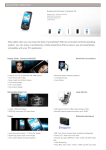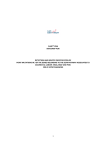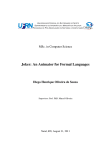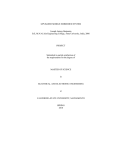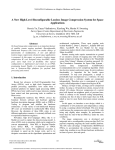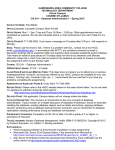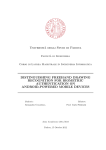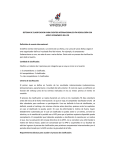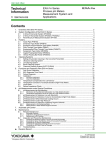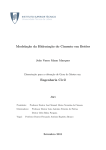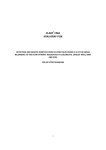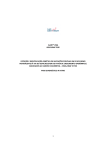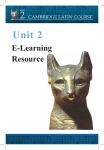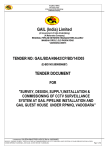Download A Proposal for Test Data Standardization for Handsets Evaluation in
Transcript
XXVI SIMPÓSIO BRASILEIRO DE TELECOMUNICAÇÕES - SBrT’08, 02-05 DE SETEMBRO DE 2008, RIO DE JANEIRO, RJ
A Proposal for Test Data Standardization for
Handsets Evaluation in Simulated Networks
Clauirton Siebra, Paulo Costa, Fabio Q. Silva and André M. Santos
Abstract— More thorough testing prior to deployment and a
reduced time to market are competing objectives that handset
manufacturers must try to optimize. Thus, the evolution of
test methodologies, with the use of simulation environments, is
an essential requirement to accelerate the product realization
process. One important issue for test simulation environments
is to specify the test data that is going to be used during the
simulation. Such data can be classified into two groups: the
test case batteries and the set of cells parameters that compose
a scenario. Currently, however, we have neither a standard
for a test suite that covers all the required tests for handsets
certification, nor a default benchmark of real world test scenarios.
This paper presents our approach to deal with both issues. First
we discuss our proposal to classify and specify tests cases so that
we could generate a proper test suite for handsets network tests.
Then, we present our experience in creating a database with
real information about handsets network scenarios of several
Brazilian sites.
Keywords— Network simulation, cells description, test cases,
handsets technology.
Resumo— A realização de testes em celulares e a necessidade
de um rápido lançamento de tais celulares no mercado são
objetivos conflitantes que os fabricantes devem otimizar. Consequentemente, a evolução das metodologias de testes, com o uso
de ambientes de simulação, é um requerimento essencial para
acelerar o processo de produção. Um importante aspecto dos
ambientes de simulação é a especificação dos dados de testes
que vão ser usados durante a simulação. Tais dados podem ser
classificados em dois grupos: as baterias de casos de testes e o
conjunto de parâmetros das células que compõem um cenário.
Atualmente, contudo, não existe um padrão para um conjunto de
testes que cubra todos os testes requeridos para a homologação de
um aparelho, nem uma biblioteca padrão de testes composta por
cenários do mundo real. Este artigo apresenta nossa proposta
para lidar com tais aspectos. Primeiro nós discutimos nossa
proposta para classificar e especificar casos de testes de forma que
possamos gerar um apropriado conjunto de testes para celulares.
Então, nós apresentamos nossa experiência em criar um banco de
dados com informação real sobre cenários de redes para celulares
em diversas regiões brasileiras.
Palavras-Chave— Simulação de redes, Descrição de células,
Casos de testes, Tecnologia móvel.
supported by new mobile communication and computing devices that offer a broad variety of resource and applications
to users. This has increased the pressure on the test stage of
the process, which is required to apply more extensive and
efficient procedures of evaluation so that the final product
meets the fast time-to-market goals and it can compete in the
global marketplace.
Considering this fact, the use of network simulators [1] in
laboratory, using a generated wireless network of low power, is
a trend in replacing the manual performance of tests, which use
real carriers´ networks (Field-testing). However, the appropriate use of a simulation environment requires the specification
of a test suite that is in fact able to testify the correctness of
a handset in several situations and scenarios. For that end, the
suite must consider the features of completeness (it must cover
all the tests required for different carriers and test proceedings)
and generality (it could be used to test any handset). Note that
different carriers (each carrier provides a different wireless
network) usually require different test batteries, which evaluate
subsets of network operations. Furthermore, it is important
that tests in laboratory can simulate real world scenarios. This
means the simulated cells must be configured according to
information of real handsets networks.
The remainder of this paper discusses our approaches for
dealing with these issues and it is organized as follows: Section
II introduces the handsets network test domain and presents an
environment for networks simulation, which enables the performance of network tests in laboratory. Section III discusses
the specification and classification of test cases for handsets
operating in such simulated networks. Section IV describes
the process of specifying test cases via a common template.
Section V presents our experience in creating a database
with real world information about handsets network scenarios.
Finally, Section VI concludes this work, highlighting its main
contributions and future directions of our research.
II. N ETWORK S IMULATION
I. I NTRODUCTION
The handset development has evolved into a complex engineering process, mainly because of the current capabilities
Clauirton Siebra, Paulo Costa, Fabio Q. Silva and André M.
Santos, CIn/SIDI-Samsung Laboratory of Research and Development,
Federal
University
of
Pernambuco,
Recife,
Brasil,
E-mails:
{cas,phrc,fabio,ams}@cin.ufpe.br. The results presented in this paper
have been developed as part of a collaborative project between Samsung
Institute for Development of Informatics (Samsung/SIDI) and the Centre of
Informatics at the Federal University of Pernambuco (CIn/UFPE), financed
by Samsung Eletronica da Amazonia Ltda., under the auspices of the
Brazilian Federal Law of Informatics no. 8248/91.
Network tests for handsets intend to verity if new devices
are able to perform a set of operations pre-defined by carriers. The majority of such operations, such as handovers
and reselection of cells, are default operations of any carrier
network. However, specific operations can be offered for just
one carrier. Note that this kind of evaluation do not test the user
experience features of the device, user interface, performance
of data applications, battery life and others. Rather, network
tests are mainly aimed at conformance (protocol performance,
application enabler and radio components) and interoperability
testing.
XXVI SIMPÓSIO BRASILEIRO DE TELECOMUNICAÇÕES - SBrT’08, 02-05 DE SETEMBRO DE 2008, RIO DE JANEIRO, RJ
It is known that field-testing can be costly mainly in
terms of travel, time and potential disruption to the network.
Such problems have motivated the development of simulation
environments to wireless networks, which support the performance of a significant variety of network tests. This work,
in particular, is based on our experience with the Anite/SAS
network simulator [1].
The simulation environment enables the handset to communicate within any network configuration, of up to eight
base stations, under laboratory conditions. A PC controller
runs the network simulation software and controls the base
station simulators (Cells 1 and 2). The test sets interact with
the handset under test via a normal RF interface (Fig. 1) and
to test end-to-end communication, the PC can be connected
to Internet, allowing data to be transmitted to the handset.
Using this configuration, for example, we can emulate a two
cells scenario and perform tests that involve handovers, cell
selection and cell reselection for circuit switched, packet based
and dual transfer mode (DTM) services over GSM.
There are some efforts in the direction of unifying the
performance of network tests via the creation of certifications
centers. These efforts vary with different technologies and
geographies. For example, the procedure for evaluating the
GSM technology is managed by the PCS Type Certification
Review Board in the U.S., while the Global Certification
Forum acts in other countries. Furthermore, groups like that
also elaborate documents, such as the 3GPPTS 51.010-1,
which contains collections of test cases to handsets validation.
We have used documents like that to support and aggregate
content to our test suite. Note that this process of generating
test cases is always in evolution. For example, the third
generation mobile system [4], which is based on the evolved
GSM (Global System for Mobile Communications) [3] core
networks, will require several new tests mainly associated with
multimedia transfer communication.
Then, after consolidating all the information from carriers
and certification documents, we have elaborated a classification that currently has 25 test batteries. The test cases were
mainly classified according to technological aspects and kind
of services that they are supposed to evaluate. Details about
the batteries (battery characterization, percentage1 of tests and
examples) are given in follow.
A. Dual Tone Multi-Frequency (DF)
Fig. 1.
Framework architecture.
An important feature of network simulation environments
is their flexibility in configuring cells. At the moment we
are specifying both artificial scenarios via the simulator cells
editor and real scenarios via the collection and definition
of a database contained real network information of several
Brazilian cities. Using the editor, for example, we can set the
cell identity, the channel descriptions and the frequency list.
The set of all these parameters defines a cell and the collection
of all cells defines a scenario. Using this architecture we have
performed about 59% of the total number of tests that we have
mapped.
III. A C LASSIFICATION FOR N ETWORK T ESTS
The principal sources of information, to create a suite of
tests, are the requirements of carriers. Indeed, if the carriers account for creating and maintaining wireless network
services, it is natural that such carriers also provide the
requirements that a handset must implement to operate over
their networks. However the tests provided by different carriers
are not uniform and present several variations related to
their procedures. Thus, we needed to carry out a process of
information extraction and consolidation to create a proposal
of a suite test.
Dual Tone Multi-Frequency, better known as touch-tone, is
a system of signal tones used in telecommunications. There
are twelve DF signals, each of which is made up of two tones
from the following selection: 697 Hz, 770 Hz, 852 Hz, 941 Hz,
1209 Hz, 1336 Hz, 1477 Hz. The tones are divided into two
groups (low and high) and each DF signal uses one from each
group. This prevents any harmonics from being misinterpreted
as part of the signal. The DF test battery represents 1.9% of
the test cases and it verifies if DF signals are recognized by the
network. In this way, an example of DF test is: Send DTMF
command 1.
B. Emergency Call (EC)
Many countries´ public telephone networks have a single
emergency telephone number, sometimes known as the universal emergency telephone number or occasionally the emergency service number, which allows a caller to contact local
emergency services for assistance. The emergency telephone
number may differ from country to country. It is typically a
three-digit number so that it can be easily remembered and
dialed quickly. The DF test battery represents 0.3% of the test
cases and it verifies the network recognition of emergency
calls in different situations. An example of EC test is: Make
an emergency call without SIMCARD.
C. International Mobile Equipment Identifier (IE)
The International Mobile Equipment Identifier is a unique
15-digit number used by the GSM network to identify valid
devices. Such identifier appears on the label located on the
1 Amount of test case in each battery is not definitive, as well as the amount
of batteries itself.
XXVI SIMPÓSIO BRASILEIRO DE TELECOMUNICAÇÕES - SBrT’08, 02-05 DE SETEMBRO DE 2008, RIO DE JANEIRO, RJ
back of the phone and it is automatically transmitted by the
phone when the network asks for it. The IE test battery
represents 0.2% of the test cases, which verify if the handset
has a valid identifier. An example of IE test case is: Show the
IMEI in the handset´s display.
D. International Mobile Subscriber Identifier (IS)
An International Mobile Subscriber Identity is a unique
number that is associated with all GSM and Universal Mobile
Telecommunications System (UMTS) network mobile phone
users. It is sent by the mobile phone to the network and is
also used to acquire other details of the mobile in the Home
Location Register (HLR) or as locally copied in the Visitor
Location Register [3]. The IS test battery represents 0.3% of
the test cases and it verifies the valid of IMSI operations over
the network. An example of IS test case is: Exhibition of IMSI
detach logs at BTS/Simulator.
E. Phonebook Access (PA)
The phonebook evaluation of handsets does not involve
operations over the network, so that it is not required by the
network standards testing. However, consumers and carriers
often motivate the handsets manufactures to develop this kind
of test, so that a PA battery was included in our test suite.
In this way, the PA battery represents 2.4% of the test cases
and it accounts for evaluating the operations that interact to
the handset phonebook. An example of PA test case is: Delete
a contact in SIMCARD´s phonebook through the handset´s
menu.
I. Supplementary Services (SS)
GSM supports a comprehensive set of supplementary services that complement and support the main phone and data
services. They are all defined in GSM standards and some
examples are Call Forwarding and Explicit Call Transfer. The
SS battery represents 4.6% of the test cases, which evaluate
such services. An example of SS test case is: Disable voice
calls no reply forwarding by handset´s menu.
J. International Calls (IC)
Normally, before performing an international call from
anywhere, we need to know the appropriate International
Direct Dial code (IDD) for the country that we are calling
from. With GSM however, this is not necessary because
most GSM phones have a special ´´+ key´´ feature that will
automatically insert the correct IDD code appropriate to your
current location. The IC battery represents 0.6% of the test
cases and one of their functions is to verify this ´´+ key´´
feature. An example of IC test case is: Make an international
outgoing voice call.
K. Unstructured Supplementary Service Data (US)
Unstructured Supplementary Service Data is a GSM communication technology that is used to send text between a
mobile phone and an application program in the network.
Applications may include prepaid roaming or mobile chatting.
The US battery represents 0.2% of the test case and an
example of such test is: Verify if the USSD string is NOT
in the dialed calls register.
F. Air Signaling Tests (RF)
Air Signaling or Radio Frequency tests are related to low
level network operations, such as cells´ selection, re-selection,
handovers and broadcast. The RF battery represents 3.8% of
the test cases and an example of such tests is: Re-selection
between two 900 MHz cells from the same service provider,
simulating smooth power variation.
G. Call Identification (CI)
Call identification is a switching system feature that allows
an attendant to visually identify the type of service or trunk
group associated with a call directed to the attendant’s position. The CI battery represents 2.4% of the test cases, which
deal with operations related to this kind of identification. An
example of CI test is: Receive a voice call from an originator
listed at the SIMCard´s phonebook.
H. Voice Call (VC)
Voice call is the most common operation performed over the
network and there are several situations that must be evaluated,
such as calls during handovers and using adaptive Multi-Rate
Codec (AMR) in full and half rate. The VC category represents
5.2% of the test cases and an example is: Make a voice call
to a destination that does not have neither call waiting nor
voice mail.
L. Short Message (SM)
Short Message Service is a telecommunication protocol that
allows the sending of ´´short´´ (160 characters or less) text
messages. Such messages do not require the handset to be
active and within range and will be held for a number of days
until the phone is active and within range. The SM battery
represents 7.4% of the test cases and it evaluates the SM
service in several extreme situations, such as full SIM card and
handset memory. An example of SM test case is: Send a SMS
with a 160 characters text, using only letters and numbers.
M. Enhanced Messaging Service (EM)
Enhanced Messaging Service is an adaptation of the SM
Service that allows users to send and receive ring tones and
combinations of simple media. In this way, users can integrate
text, melodies, pictures, sounds, and animations to enhance the
expressive power of messages that are limited by the display
constraints of mobile devices. The EM battery represents 4.0%
of the test cases and it evaluates the traffic of this media
over the network, as well as the correctness of its delivery
to receivers. An example of EM test case is: Send a EMS and
fill the text with no more than 160 characters, including a
picture. Check if it is correctly received by its destination.
XXVI SIMPÓSIO BRASILEIRO DE TELECOMUNICAÇÕES - SBrT’08, 02-05 DE SETEMBRO DE 2008, RIO DE JANEIRO, RJ
N. Multimedia Messaging Service (MM)
Multimedia Messaging Service is a communication technology developed by 3GPP that allows users to exchange
multimedia communications between handsets and other devices. This service is an extension and improvement of the
EM service, which supports, for example, transmission of
streaming video. Furthermore, unlike SM and EM services,
the size of an MMS message is unlimited, although service
providers are likely to impose their own size restrictions.
To fully operate, the MM service requires a 3G network.
Temporarily, however, this service has been based on the
General Packet Radio Services (GPRS), which implies some
limitations (a good discussion about this evolution is presented
in [5]). The MM battery represents 13.9% of the test cases and
we are considering the GPRS-based operations, while the 3Gbased battery [2]) is part of our future extensions (they are
already mapped but not implemented). An example of MM
test case is: Receive a MMS with subject. Fill the image object
with images of different sizes and formats (GIF, Animated GIF,
PNG and WBMP).
O. Wireless Application Protocol (WP)
The Wireless Application Protocol, or WAP, is an open
international standard for applications that use wireless communication. Its principal application is to enable access to
Internet from a handset. The aim of the WP battery, which
represents 5.5% of the test cases, is to evaluate the use of this
protocol by the handset, such as connection to WAP sessions
and use of PDP (Packet Data Protocol) context. An example
of WP test case is: Make a GPRS Detachment by handset´s
menu, without having activated a PDP context.
P. Browser (BW)
A handset browser provides all of the basic services of a
computer based web browser, but simplified to operate within
the restrictions of a handset. In this way, the BW battery
represents 8.2% of the test cases and it accounts for evaluating
such services. An example of BW test case is: Go to a WML
URL, test and check correct visualization and execution of
buttons and inputs elements.
Q. AT Commands (AT)
Most GSM/UMTS handsets include an internal modem,
which recognizes AT commands. Thus several operations,
defined in the 3GPP TS 27.007 specification [6], can be performed using such commands. For example, standard phonebook access or short messages (SMS) sending, modification
and deletion. The AT battery, which represents 4.4% of the test
cases, considers these operations and an example is: Initiate a
voice call using ATD command.
R. Java(JV)
During the last years, Java is increasing its role as handset
platform. One of the reasons is the popularization of J2ME
(Java 2 Micro Edition) as development language for handsets.
This justifies the specification of a JV battery, whose tests
cases evaluate the ability of handsets to download and execute
Java applets. At the moment the JV battery represents 0.2%
of the test cases and an example of such tests is: Make a Java
Application download and test it.
S. SIM Card (SC)
A Subscriber Identity Module (SIM) is a removable smart
card that stores network state information which is broadcast to
it from the network, such as the Location Area Identity (LAI).
Another SIM function is to store a key identifying the handset
service subscriber. The use of SIM cards is mandatory in the
GSM world, so that their evaluation is part of the network test
requirements. In this way, the SC battery represents 2.0% of
the test cases and it basically verifies the SIM card capabilities.
An example of SC test case is: Test the network lock by service
provides.
T. Bluetooth (BT)
Bluetooth is a radio standard and communications protocol
primarily designed for low power consumption, with a short
range (1 meter, 10 meters or 100 meters) based on low-cost
transceiver microchips in each device. Bluetooth lets these
devices communicate with each other when they are in range.
The devices use a radio communications system and they do
not have to be in line of sight of each other. The BT battery
represents 7.1% of the test cases and an example of test is:
Verify that the handset discovers any devices situated nearby.
U. Functionalities-Test (FT)
The FT battery considers several test cases that are not
related to network validations, however they are provided
as a form to complete the handset validation. This battery
represents 1.4% of the test cases and an example is: Create a
welcome message and verify if it appears correctly when turn
on the handset.
V. E-mail (EL)
The ability of sending and receiving e-mails is becoming
a very common feature of handsets. In the same way that
e-mails are provided by normal computer desktops, e-mails
from/to handsets must consider a set of requirements, such as
text format and the capability to annex several types of file
format, such as figures and music files. The EL battery, which
represents 8.0% of the test cases, intends to evaluate all these
functions related to e-mail service for handsets. An example
of EL test is: Send an email without subject, with text, and
with attached sound files in different formats.
W. Streaming (ST)
Streaming is the kind of multimedia that is constantly
received by, and normally displayed to, the end-user while
it is being delivered by the provider. The name refers to the
delivery method of the medium rather than to the medium
itself. The ST battery, which represents 8.4% of the test cases,
XXVI SIMPÓSIO BRASILEIRO DE TELECOMUNICAÇÕES - SBrT’08, 02-05 DE SETEMBRO DE 2008, RIO DE JANEIRO, RJ
evaluates the ability of the handset in receiving this kind of
media. An example of ST test is: Establish a streaming
session with a server providing live content composed of video
and audio where the audio is encoded using AMR-NB and the
video using H.264/ MPEG4-AVC.
the manual execution of the tests. However, considering the
execution in a simulation environment, they must be translated
to simulation scripts and such translation is dependent of the
representation language used by each simulator.
X. UAProf (UA)
The User Agent Profile (UAProf) specification is concerned
with capturing capability and preference information for wireless devices. This information can be used by content providers
to produce content in an appropriate format for the specific
device. The evaluation of related UAProf features is carried out
by the UA battery, whose tests account for 4.7% of the total
number of tests. An example of test is: User-Agent launched
by MMS clients and URL of the UAProf.
Y. Roaming Broker (RB)
The Roaming Broker platform enables a GSM carrier to act
as a hub for roaming traffic by policing signaling traffic in a
centralized location. It operates as an enhanced gateway with
filtering rules tailored for roaming, which enables carriers to
act as brokers between roaming partners. It also has additional
interoperability and security mechanisms to simplify provisioning, maximize inter-working and ensure network integrity.
All these features are considered by the RB battery, which
represents 2.6% of the test cases, and an example of test is:
Location Update Reject - PLMN Not Allowed at two 1900
MHz cells with PIN1 enabled.
IV. T EST C ASES S PECIFICATION
The next step, after the test cases classification, is to identify
and organize the common concepts related to test cases so that
they can be represented in a unified way. From our analysis,
we have defined the following concepts:
- Test Case Identifier: a unique key that identifies a test
case (TC) among all the test cases collection. The pattern
proposed in our project is <xx TCyyy>, where ´´xx´´
represents the battery identifier and ´´yyy´´ represents the
TC number. For example, SM TC003 is the third test case
of the Short Message (SM) battery;
- Description: a short description about the main function
of a test case;
- Preconditions: required initial conditions to the performance of a test case;
- References: indicate the files, such as the test scripts,
associated with a test case;
- Estimated time: average required time to perform a test
case;
- A list of n test case steps: steps can be represented by
the 4-tuple <step,technique,procedure,expected-result>
where step is a sequential integer value, technique specifies if the step is manual or automatic, procedure is
the description of the step, and expected-result is any
verification to be checked on the handset display or on
the simulator execution log.
Such concepts are organized in the template of Fig.2 in order
to create the test cases. Test cases can be directly used to lead
Fig. 2.
Example of test case specification.
V. DATABASING R EAL S CENARIOS
Network simulators provide basic cells that we can configure to create scenarios according to specific needs. However,
some carriers require the test performance in their own networks, using their cells and parameter, so that they can be
sure if the handsets work properly in such networks. To still
perform the tests in laboratory, we have decided to create a
database with information of several real networks, so that
the simulator could load this data and run simulations of real
scenarios. This process is detailed in the next sections.
A. Evaluation of Tools for Capture
The first step to create a database with real network scenarios is to use a real time network monitoring tool that
can capture information about cells and their parameters.
Such tools are referred here as Wireless Network Capture
Tools (WNCT) and we have analyzed three of them: SAGEM
OT290, TEMS and NEMO.
SAGEM OT209 is a WNCT that was designed to support
the validation of GSM and GPRS networks. This tool is
composed by a handset-like hardware and a GSM/GPRS
software that enables the visualization, recording and replay
of all information. The physical interface is based on standard
serial interface, which makes easier the use of the terminal
in both trace and transfer modes. SAGEM is able to store
measurements made in real time without the need of an
external memory device. However its capability is limited,
so that it is important to continually download the data to
a computer using the data interface in trace mode or using an
infrared connection. Apart its good usability, we have found
out problems of compatibility between the SAGEM data and
the Anite simulator. After loading the collected cells and
configure the scenarios using such cells, we have noticed that
several operations, such as Location Update, did not work
properly. To attenuate this problem, we have changed some
cells´ parameters, turning them more ´´friendly´´ to Anite. This
action had some positive effects, so that some operations, such
XXVI SIMPÓSIO BRASILEIRO DE TELECOMUNICAÇÕES - SBrT’08, 02-05 DE SETEMBRO DE 2008, RIO DE JANEIRO, RJ
as handovers between cells, were possible. However, other
operations were still presenting problems and we could not
apply more changes to the cells because this action could lead
to cells that do not represent the real-world collected scenarios.
TEMS is an Ericsson tool that offers data collection, realtime analysis and post-processing function. One of the main
aims of TEMS is to offer a multi-vendor and multi-technology
support, considering the major vendors (e.g, Samsung, Motorola, Nokia, etc.) across multiple technologies (e.g, GMS,
CDMA, etc.). The collected data from TEMS is presented
in real time and its interface allows users to filter network
data and focus on relevant information for in-depth analysis.
Differently from SAGEM, the TEMS tool is composed by
mobile, a PC and GSM/GPRS software that must be together
during the data collection. The import of TEMS data by Anite
requires the use of a specific template, which should ensure
data compatibility between the two environments. Unfortunately, ever using such template, we were not able to create
cells, using the collected data, in the Anite simulator.
NEMO is another option for portable engineering tool
designed for measuring and monitoring the air interface of
wireless networks. This tool is able to support measurements
on GSM, GPRS, EDGE and WCDMA networks. Our analysis
has identified that NEMO is more flexible than TEMS and
SAGEM because it permits the log files export in different
format, which means that the formats can be open and developers have more flexibility to work with the integration of the
NEMO´s data with other applications. Another positive feature
is the Quadri-band capability of NEMO. This means that it
is able to collect data from 850MHz, 900MHz, 1800MHz
and 1900MHz, depending on the handset model. However, the
principal fact related to NEMO is its ongoing integration with
Anite environment, which will enable a complete compatibility
between these two environments.
B. The Process of Capture
The previous section raised out several features of the main
tools for capture currently available in the market. In fact, the
main aspect to lead the choice for a WNCT is its compatibility
with the simulation environment in use. The second step to
create a database of real scenarios is to define the cycles of
capture. We define a cycle as a tuple <route,carrier>, where
route defines a set of paths through where the data collection
must be done; and carrier identifies one of the carriers that
operates in the region.
The main idea in defining a route is to consider that this
route goes through representative locations in terms of cells
diversity and network traffic. Note that these locations are
associated with a carrier so that the same route may not be
valid for two or more carriers. Fig. 3 shows an example of
route defined to capture data from four important sites of a
carrier in the city center of São Paulo.
Currently we have collected information about 34 cycles,
considering 12 cities and 6 different carriers. The data capture
for this set of cycles must be carried out at least once a year,
so that the database can actually represent the current state of
real cells and scenarios.
Fig. 3.
Example of route, considering important sites of a specific carrier.
VI. C ONCLUSIONS AND D IRECTIONS
This paper has two main contributions. First, a proposal for
classification and specification of handsets network test cases.
Second, a discussion about important steps for the database
creation of real wireless network scenarios. Both contributions
are initial efforts towards the definition of a standard process
for certification of handsets similar to those carried out by
the PCS Type Certification Review Board PTCRB or Global
Certification Forum GCF. In fact, there is a lack in Brazil of
such kind of service, so that the task of certification is usually
performed by the carriers themselves. Future efforts of this
work aim to provide a complete test suite and database of
network scenarios for handset certification. For that end, we
need to work closer with network carriers to develop a certification program that ensures full interoperability, considering
the particular features of the Brazilian networks.
ACKNOWLEDGES
The authors would like to thank all the test engineers of
the CIn/SIDI-Samsung Test Center (Amanda Araujo, Anniele
Costa and Ronaldo Bitu), which provided the technical details
about the handsets network test domain, simulation environment and GSM principles. The team is also grateful for the
support received from Samsung/SIDI team, in particular from
Ariston Carvalho, Miguel Lizarraga, Ildeu Fantini and Vera
Bier. The National Council for Scientific and Technological
Development (CNPq) has provided valuable support to the
project through the Brazilian Federal Law no. 8010/90.
R EFER ÊNCIAS
[1] Anite SAS 12447D/UMOOI GSM-9OO/DCSI800 /PCS-1900. Stand
Alone Simulator User Manual, rel. 3.0, Anite Telecoms Ltd, Fleet,
Hampshire, UK, 1999.
[2] V. Garg, Wireless Network Evolution 2G to 3G. Prentice Hall, 2001.
[3] M. Rahnema, Overview of the GSM system and protocol architecture,
IEEE Communications Magazine, 42(4):493-502, 1993.
[4] The 3rd Generation Partnership Project (3GPP), Mobile Station (MS)
conformance specification; Part 1: Conformance specification, 2006,
Available in: http://www.3gpp.org/ftp/Specs/html-info/51-series.htm
[5] J. De Vriendt, P. Laine, C. Lerouge, and X. Xiaofeng, Mobile network
evolution: a revolution on the move, IEEE Communications Magazine,
40(4):104-111, 2002.
[6] The 3rd Generation Partnership Project (3GPP), AT command set for User Equipment (UE), 2007. Available in:
http://www.3gpp.org/ftp/Specs/html-info/27007.htm






